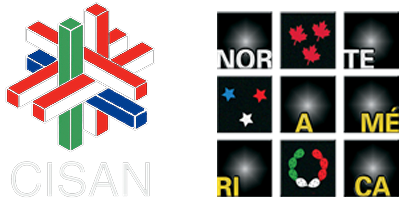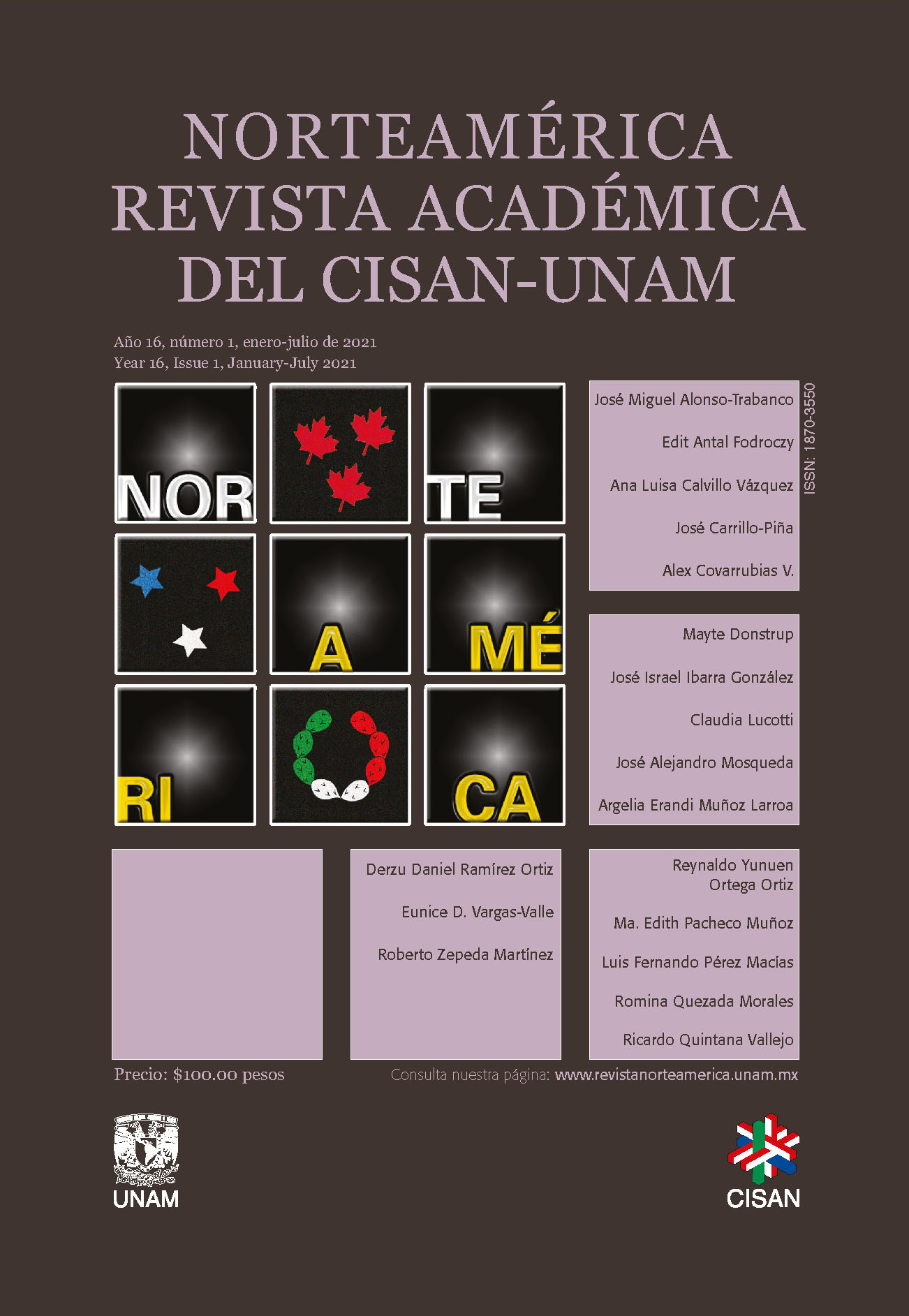Abstract
In this article we posed several questions: What was the explanatory capacity of inequality and poverty at the state level in the United States presidential elections in 2012 and 2016?; what was the state balance in the presidential elections in the United States? By using the “American National Election Studies Survey”, We also investigated the individual level to try to figure what variables could help us understand the vote in favor of the Republican presidential candidates in 2012 and 2016? Thus, to answer our questions, we conducted two analyzes, one at the state level and the other, based on individual voters, in order to explain the contrasting results of 2012 and 2016.
References
2014 “Long-Term Trends and Short-Term Forecasts: The Transformation of US Presidential Elections in an Age of Polarization.”, en PS: Political Science & Politics, vol. 47, núm. 2, pp. 289–292.
American National Election Studies – Data Center
2012 “Electoral Studies Survey”, 2016 Time Series Study. Disponible en: https://electionstudies.org/data-center/2012-time-series-study/. Consultado el 4 de noviembre de 2019.
2016 “Electoral Studies Survey” de los: 2016 Time Series Study. Disponible en: https://electionstudies.org/data-center/2016-time-series-study/. Consultado el 4 de noviembre de 2019.
Bartels, Larry
2000 “Partisanship and voting behavior, 1952-1996”, en American Political Science Review, vol. 44, núm. 1, pp. 35-50.
Bartels Larry
2008. Unequal Democracy: The Political Economy of the New Gilded Age, Princeton, NJ., Princeton University Press.
Bureau of Economic Analysis U.S. Department of Commerce
2019 “GDP by state”. Cifras actualizadas al 1 de mayo de 2019, Disponible en: https://www.bea.gov/data/gdp/gdp-state, Consultado el 7 de julio de 2019.
Campbell, Angus, Philip Converse, Warren Miller, y Donald Stokes
1960 The American Voter. New York, Wiley.
CNN.
2012. President: Full results: Exit polls. 10 de diciembre 2012, Disponible en http://www.cnn.com
Collingwood, Loren ; Matt A. Barreto, y Sergio I. García Ríos
2014 “Revisiting Latino Voting: Cross Racial Mobilization in the 2012 Election”, en Political Research Quarterly, vol. 67, núm. 3, septiembre, pp. 632-645.
Converse, Philip .E.
2006. “Democratic theory and electoral reality”, en Critical Review, vol. 18 pp. 297–329.
Fiorina, M. P.
1981 Restrospective Voting in American National Elections, New Haven, CT, Yale University Press.
Fiorina, M. P., S. J. Abrams y J. C., Pope.
2005. Culture War? The Myth of a Polarized America, New York, Longman.
Gallup.
2016. Election polls - Presidential vote by groups. Available from http://www.gallup.com/ poll/139880/Election-Polls-Presidential-V
Gelman, Andrew
2008 Red State, Blue State, Rich State, Poor State. Why American Vote the Way They Do (Expanded Edition), Princeton, Princeton University Press, pp 218.
Jacobson, Gary
2016. “Polarization, Gridlock, and Presidential Campaign Politics in 2016”, The Annals of the American Academy of Political and Social Science, Septiembre, Vol. 667, pp. 226-246.
Key, V. O.
1966 The responsible electorate: rationality in presidential voting, 1936-1960. Cambridge, Mass., Belknap Press of Harvard University.
Kilson, Martin
2011 “Analysis of Brack American Voters in Obama’s Victory”, en The Obama Phenomenon: Toward a Multiracial Democracy, Charle P. Henry, Robert L. Allen y R. Chrisman, University of Illinois Press, pp. 34-59.
Lazarsfeld, Paul F., Bernard Berelson, and Hazel Gaudet
1944 The People’s Choice: How the Voter Makes up his Mind in a Presidential Campaign. New York, Columbia University Press.
Lowi Theodore y Benjamin, Ginsberg
1996 American Government. Freedom and Power, 4th Edition, New York, W. W. Norton Company.
Massachusetts Institute of Technology (MIT) Election Data and Science Lab
2019 "U.S. President 1976–2016", en Data and Science MIT Election Lab 2017, Harvard Dataverse, V5, UNF:6:Mw0hOUHAijKPTVRAe5jJvg== [fileUNF], Disponible en: https://dataverse.harvard.edu/dataset.xhtml?persistentId=doi:10.7910/DVN/42MVDX. Consultado el 3 de julio de 2019.
McFayden, Elgie C.
2013 “The Politics of Race During the Obama Era”, en Race, Gender & Class, vol. 20, núm.3-4, pp. 7-17.
Pew Research Center.
2014. Political polarization in the American public. Research report. Washington, DC: Pew Research Center.
Pomper, Gerald M. y Susan S. Lederman
1980 Elections in America: Control and Influence in Democratic Politics, 2nd ed., New York, Longman.
Population Reference Bureau
2018 “United States Indicators, Gini Index of Income Inequality”, de U.S. Census Bureau, American Community Survey. Disponible en: https://www.prb.org/usdata/indicator/gini/chart/. Consultado el 1 de julio de 2019.
Rappeport, Alan
2016 “Mormons’ Distatest for Donald Trump Puts Utah Up for Grabs”, New York Times, agosto 9, disponible en : https://www.nytimes.com/2016/08/10/us/politics/mormons-trump-utah.html, Consultado el 6 de julio de 2020.
Reiter, Howard L.
1987 Parties and Elections in Corporate America. New York, St. Martin Press,.
Sorrentino, John A., y Mahbubur R. Meenar.
2006 "United States." Encyclopedia of World Poverty, edited by M. Odekon, vol. 3, SAGE Reference, 2006, pp. 1106-1116. Gale eBooks, https://link.gale.com/apps/doc/CX3469800742/GVRL?u=colmex&sid=GVRL&xid=82c92f00. Consultado, 8 julio 2020.
Tyson, Alec y Shiva Maniam
2016 “Behind Trump’s victory: Divisons by race, gender and educaction”, Pew Research Center, november 9, disponible en : https://www.pewresearch.org/fact-tank/2016/11/09/behind-trumps-victory-divisions-by-race-gender-education/ Consultado, 8 agosto 2020.
United States Census Bureau
2010 “Census Urban and Rural Classfication and Urban Area Criteria”. Disponible en: https://www.census.gov/programs-surveys/geography/guidance/geo-areas/urban-rural/2010-urban-rural.html. Consultado el 3 de septiembre de 2019.
Weinschenk, Aaron.
2013, “Polls and Elections: Partisanship and Voting Behavior: An Update” en, Presidential Studies Quarterly, vol. 43, núm 3, Septiembre, pp. 607-617.
Authors who publish with this journal agree to the following terms:
Copyright Retention and License Grant:
Authors retain copyright of their work and grant the journal a non-exclusive right of first publication. The work is licensed under a Creative Commons Attribution-NonCommercial 4.0 International License (CC BY-NC 4.0), which permits others to share and adapt the work for non-commercial purposes, provided they give appropriate credit to the author and acknowledge the work’s initial publication in this journal.
Additional Distribution: Authors are free to enter into separate, additional contractual arrangements for the non-exclusive distribution of the journal’s published version of the work (e.g., posting to an institutional repository, publishing in a book, or other distribution), provided they acknowledge the work’s initial publication in this journal.
Pre- and Post-Publication Sharing: Authors are permitted and encouraged to share their work online (e.g., in institutional repositories, personal websites, or academic platforms) before, during, or after the submission process, as this can foster productive exchanges and increase the visibility and citation of the published work, subject to the terms of the CC BY-NC 4.0 license.



